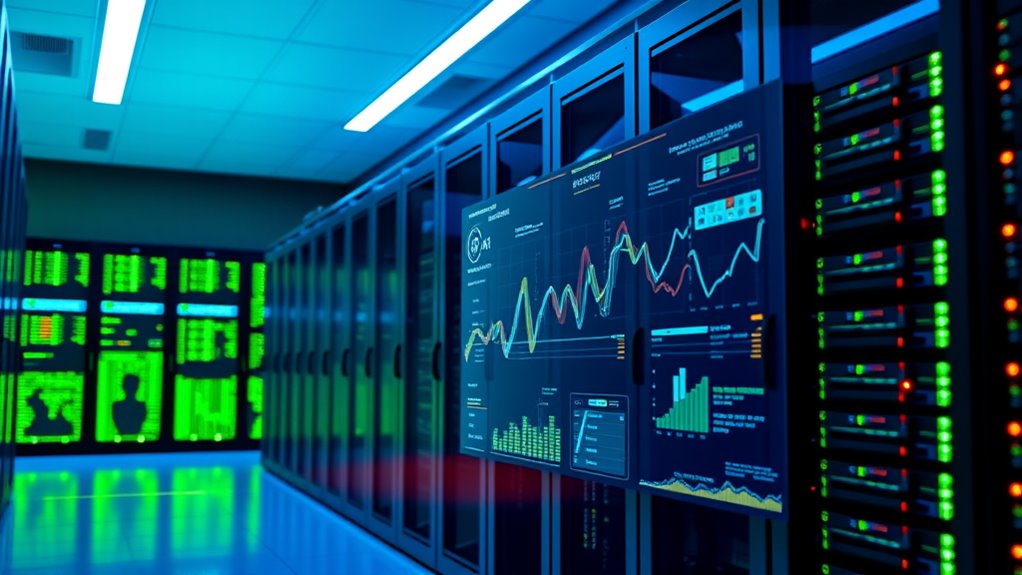AI analytics plays a vital role in intrusion detection by helping you recognize behavioral patterns, identify anomalies, and predict threats before they cause harm. It continuously learns from vast data, establishing a baseline of normal activity and flagging deviations as potential issues. This proactive approach allows your systems to adapt to emerging threats and reduce false positives. Keep exploring how AI-driven analytics can strengthen your security and stay ahead of cybercriminals.
Key Takeaways
- AI analytics establish baseline behaviors to detect anomalies indicating potential intrusions.
- They analyze vast datasets in real-time to identify subtle attack patterns and deviations.
- AI models adapt continuously, learning new tactics to improve detection accuracy over time.
- They predict and preempt threats by analyzing historical and behavioral data for potential attack vectors.
- AI-driven systems prioritize alerts and automate responses, enhancing proactive network security.

Have you ever wondered how modern networks stay ahead of cyber threats? The answer lies in the power of AI analytics, especially when it comes to understanding behavioral patterns and enhancing threat prediction. Traditional security systems rely heavily on predefined rules and signatures, which often struggle to identify new or evolving threats. AI analytics, however, continuously learns from vast amounts of data, enabling you to detect anomalies that might otherwise go unnoticed. By analyzing behavioral patterns over time, AI models can establish a baseline of normal activity within your network. When deviations from these patterns occur, the system flags them as potential threats, providing an early warning that helps you respond swiftly. This proactive approach minimizes damage and reduces false positives that can overwhelm manual monitoring efforts.
In intrusion detection, understanding behavioral patterns isn’t just about spotting unusual activity; it’s about recognizing subtle shifts that could indicate an impending attack. AI algorithms sift through network logs, user behaviors, and system events to identify these shifts with remarkable accuracy. For example, if an employee suddenly accesses files outside their usual scope or logs in at odd hours, AI detects these anomalies and assesses their risk level. These insights allow you to prioritize alerts, focusing your attention on genuine threats rather than wasting time on benign anomalies. This continuous learning process makes your defenses smarter over time, adapting to new tactics that cybercriminals develop. Additionally, AI systems can incorporate real-time analytics to process data instantly, further enhancing detection capabilities.
Threat prediction is another critical aspect where AI analytics shine. By analyzing historical data and behavioral patterns, AI models forecast potential attack vectors and vulnerabilities before they can be exploited. Instead of waiting for an attack to happen, you gain the ability to anticipate and prevent threats proactively. For instance, if a pattern of suspicious activity suggests an attacker attempting lateral movement within your network, the system can alert you or even trigger automated responses to isolate affected systems. This predictive capability transforms your security posture from reactive to proactive, giving you a significant advantage over cybercriminals.
Moreover, AI’s ability to process and analyze immense datasets quickly means that threat prediction remains dynamic and up-to-date. As new attack techniques emerge, AI systems learn and adapt, refining their ability to identify early warning signs. This constant evolution ensures your network stays resilient against evolving threats. Overall, AI analytics empower you with a deeper understanding of your network’s behavioral landscape, providing real-time insights and foresight that traditional systems simply cannot match. With these tools, you’re better equipped to detect, predict, and prevent cyber threats before they cause serious harm.
Frequently Asked Questions
How Does AI Analytics Adapt to Evolving Cyber Threats?
AI analytics adapts to evolving cyber threats by continuously performing behavioral modeling and real-time analysis. You benefit from AI’s ability to identify new attack patterns and anomalies quickly, even as threats change. This dynamic approach helps you detect sophisticated intrusions early, minimizing damage. As threats evolve, AI updates its models automatically, ensuring your security system stays ahead of cybercriminals and maintains robust defense mechanisms.
What Are the Privacy Concerns With Ai-Based Intrusion Detection?
Did you know that 78% of consumers worry about data privacy? With AI-based intrusion detection, you face concerns over data privacy and ethical considerations, as sensitive information is analyzed to identify threats. You must balance security benefits with protecting user privacy, ensuring compliance with regulations, and maintaining trust. Addressing these privacy concerns is essential to avoid misuse of data and uphold ethical standards in cybersecurity efforts.
How Does AI Compare to Traditional Intrusion Detection Systems?
AI outperforms traditional intrusion detection systems by utilizing behavioral analysis to identify subtle threats that signature-based methods might miss. It adapts quickly to new attack patterns, reducing false positives and improving accuracy. While traditional systems rely on predefined rules, AI learns from data, making it more effective at detecting sophisticated intrusions and minimizing disruptions. This proactive approach helps you stay ahead of evolving cyber threats.
What Industries Benefit Most From Ai-Driven Cybersecurity?
You benefit most from AI-driven cybersecurity in industries like finance and healthcare. AI helps protect financial security by detecting fraud and unauthorized access swiftly. In healthcare, it enhances monitoring systems, ensuring patient data remains safe and compliance is maintained. By leveraging AI analytics, you can identify threats faster, reduce false positives, and strengthen your overall security posture, making these industries especially resilient against cyberattacks.
How Can Organizations Implement AI Analytics Effectively?
You should start by establishing clear objectives and integrating behavioral modeling to understand normal activity. Use data visualization tools to monitor patterns and detect anomalies in real-time. For example, a financial firm improved threat detection by combining AI analytics with visual dashboards, enabling quick responses. Regularly train your models with updated data, and foster collaboration between IT and data teams to guarantee effective AI implementation.
Conclusion
By harnessing AI analytics, you unlock a powerful shield against cyber threats, turning data into your vigilant guardian. As the horizon of cybercrime expands, your ability to detect and respond swiftly becomes more critical than ever. Remember, AI isn’t just a tool—it’s your silent sentinel, ever-watchful in the shadows. Embrace its potential now, for in the domain of cybersecurity, a proactive stance is the only way to stay one step ahead in the perpetual dance of defense.









